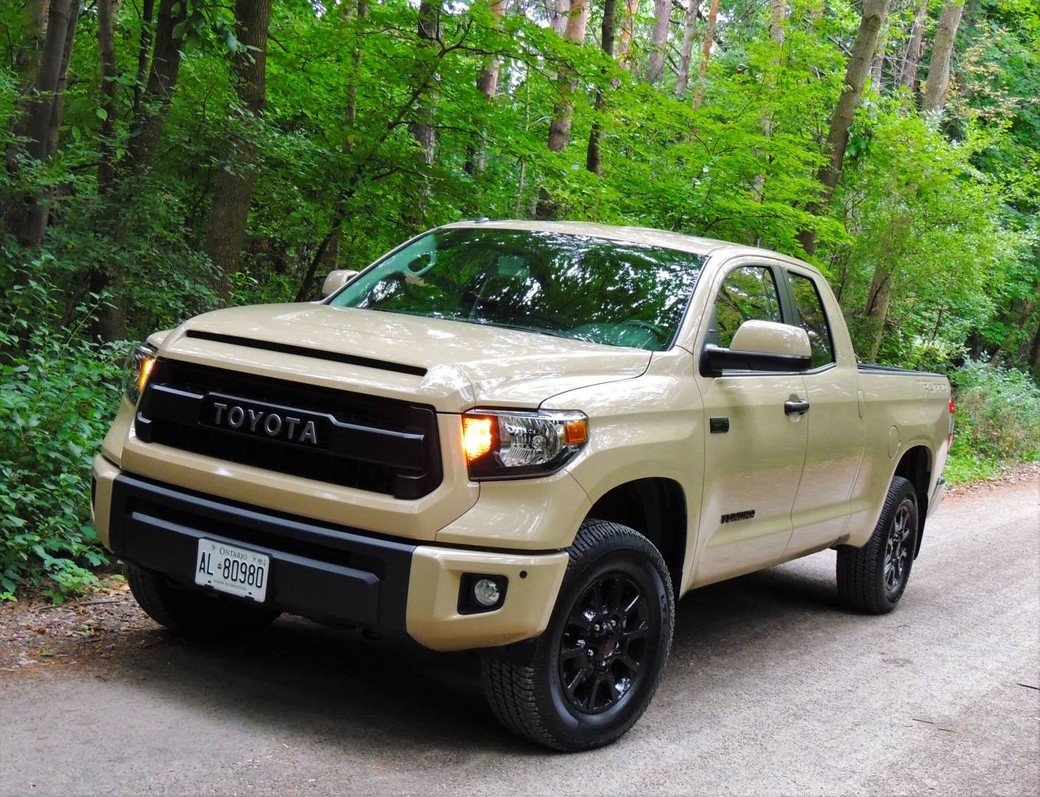
Living large in Toyota’s brawniest ride
All photos by Neil Moore.
A little less than full-size and with an engine that almost could, the first Tundra didn’t quite measure up in terms of bulk and brawn. This pickup was by no means a 90-pound weakling, but brand-loyal truck buyers just didn’t see it as a serious contender to the Ford F-150, Chevy Silverado and Dodge Ram. That is, until the second generation came along in 2007. Since then nobody has been kicking sand on Toyota’s largest vehicle. Particularly, the TRD (which stands for Toyota Racing Development Pro version) as tested.
All Tundras have that square’ish, industrial look that is popular among North American truck buyers, nothing “slippery” or aerodynamic here. Its whopping grille slams the air like a fist. Its chiseled upright sides and large wheel openings won’t score top marks in any wind tunnel testing.
TRD Pro amps up the rugged look. It’s a functional package that adds styling cues like big block lettering on the black-painted grille, TRD Pro bed-side stamping and other badging, along with 18-inch black alloys with beefy all-terrain tires, skid plates in front and over the fuel tank, performance exhaust system (more on that later) and a 50-mm lift to make this truck even more awesome.
Although Tundra is available in three cabs (regular, DoubleCab, and CrewMax), two or four-wheel-drive, and with two engines (4.6- or 5.7-litre), TRD Pro comes only in the two larger cabs and with the more potent V8. As an off-roader, it naturally gets drive to all four wheels –in this case a part-time system that toggles between RWD (for better fuel economy and driveability) and 4WD with the twist of a knob.

TRD pricing is at the upper end of Tundra’s lineup, which spans 10 models and 22 packages. Sure, you can purchase a basic work truck for just under $30K (4×2, regular cab, and no rear seats), but TRD Pro is nearly double that at $54,975 for the DoubleCab and $57,475 for the stretched CrewMax.

Mine was the DoubleCab, with its modest rear quarters that accommodates three average-sized adults ahead of its 6.5-foot cargo bed. CrewMax offers more leg room, but gets a 5.5-foot bed. Either way, the tailgate is damped making it easy to lift and lower single-handed and there’s enough space between the wheel wells to slide in a 4×8 sheet of plywood. Moveable cleats are handy for securing taller items like fridges, stoves and large furniture.
Although Tundra has a maximum payload of 1,895 lbs (855 kg) and will tow up to 10,500 lbs (4,760 kg), that applies to the base 4×2 Regular Cab Long Bed with standard 5.7L V8. My TRD Pro could carry 1,420 lbs (645 kg) and tow 9,700 lbs (4,400 kg) It may not be best in class, but should handle most needs.

It also gets a towing package, which includes trailer brake controller, heavy-duty hitch receiver, transmission cooler and 4+7 pin connectors. Suspension is Bilstein coil-over shocks in front and Bilsteins with leaf springs in back. It’s not a cushy ride, but decent for an off roader. My advice: if you want something that doesn’t ride like a truck, don’t buy a truck. Like most Tundra models, the TRD gets the 32-valve, DOHC 5.7-litre i-Force V8 that delivers 381 hp and 401 lb/ft of torque. I’ve driven the 4.6-litre (310 hp, 327 lb/ft), but it doesn’t pack the same punch. Mated to a six-speed automatic with sequential shift mode, the 5.7-equipped Tundra sprints off the line with strong, linear acceleration aided by sport mode with its quicker throttle response and later shifts. TRD Pro has the added benefit of its performance dual exhaust system.
Prod the pedal when idling and you’ll hear a nice, deep burble. Plant it while entering an on-ramp, and it bellows like an angry rhino, rising in pitch as the Tundra climbs eagerly towards highway speed. The sound is addictive, and as good as anything I’ve heard the top V8-powered muscle cars. But don’t succumb to this temptation or you’ll be matching my 19.5 litres/100 km fuel economy –slightly worse than Tundra’s already thirsty 18.2/14.1/16.3 L/100 km (city/hwy/comb) NRCan rating.
Inside, the TRD Pro is more civilized. Instrumentation is neat and uncluttered, with analog controls flanking the large infotainment screen. Volume and tuning are controlled by two old-school knobs, as they should be. Beefy knobs and buttons –big enough for the gloved hand– also manage the HVAC.
Other TRD content includes black leather upholstery with red stitching, heated front buckets with eight-way power adjust for the driver, navigation system, power rear window, rear parking sensors and more.
Storage is aplenty, with a laptop-swallowing console box between the seats, and plastic bins beneath the rear bench. It’s great for hiding valuables.
Owning a big truck like the TRD Pro makes you painfully aware just how small today’s parking spots have become, especially when wedging it between two stocky SUV. Navigating downtown laneways feels like landing a jumbo jet. But you do feel a sense of dominion among the lesser rides, scurrying about at ground level and unable to see the horizon you’ve just blocked. As Tom Petty once said: “It’s good to be king –if just for a while.”

SNAPSHOT: 2016 Toyota Tundra TRD Pro
BODY STYLE: full-size pickup truck
ENGINE: (as tested) 32-valve, DOHC 5.7-litre V8 (381 hp and 401 lb/ft of torque)
TRANSMISSION: six-speed automatic with manual shift mode, part-time four-wheel-drive
FUEL ECONOMY: as tested, 18.2/14.1/16.3 L/100 km (city/hwy/comb)
PAYLOAD: 645 kg (1,420 lbs)
TOWING: 4,400 kg (9,700 lbs)
PRICING: TRD Pro package – $54,975 for DoubleCab (as tested); $57,475 for CrewMax
WEBSITE: toyota.ca









